Heading out the door? Read this article on the new Outside+ app available now on iOS devices for members! Download the app.
Anxiety. Sometimes even just reading the word can be triggering.
Anxiety is a broad condition that encompasses a huge range of meanings. For some, anxiety means a little underlying hint of nerves before heading into a meeting; for others, anxiety is a debilitating condition that includes worry or panic—the kind that makes it impossible to feel safe leaving your home.
Anxiety disorders are the most common mental illness in the U.S., affecting 40 million adults in the United States age 18 and older—or 18.1% of the population—according to the Anxiety and Depression Association of America. And in the yoga community, having anxiety is somewhat stigmatized because of the preconceived assumption that if you practice yoga seriously, you should be calm and stress free. Yet we’re all human, as well as imperfect. Which means of course, you can be a yogi who also deals with anxiety.
See also 6 Steps to Tame Anxiety: Meditation + Seated Poses
The First Step to Ease Anxiety Is Learning How to Accept It
Those with anxiety know that some days, no matter how much you do to avert it, the anxiety is there to stay. So, instead of resisting what is (read: feeling anxious), why not try accept and embrace your anxiety?
The first way to move toward acceptance and away from resistance is to ask: “What is my anxiety trying to teach or show me right now?” Reflecting on this question may help us find insights that switch our perspective from anxiety being a “bad” thing that we have to get rid of, to something that gives us an opportunity for growth. This changes everything. When we look at anxiety as a teacher, it opens up the possibility for growth in areas that we have not yet reached before. Most of time when we try to resist or control something, it’s because we do not feel safe. Reminding ourselves that everything that is happening is for our personal growth and benefit can help us to relax a bit more and trust in the timing of our lives.
See also Yoga for Anxiety: Overcoming Panic Attacks with Yoga
Why You Should Actually Be Grateful for Anxiety
Another technique to change your relationship to anxiety is to try to cultivate a sense of gratitude for it. (Yes, you read that right!)
Most of the time, anxiety is the result of repressed emotions that need to be released. This can be repressed grief, sadness, anger, or fear (just to name a few) that are now manifesting as anxiety since they have not yet been expressed in their true form. Even though we’ve trained our minds so well to swallow certain negative emotions, our bodies seek the opposite and try to release these stored energies through any means possible. If not released in a healthy way, these trapped emotions will manifest as anxiety or illness.
So, when anxiety shows up in our lives, the practice of learning how to be grateful for it can be truly transformative, as it helps us learn that anxiety may just be the body’s way of trying to signal that there are some deep-seated, repressed emotions hiding below the surface, and that we are now ready to release them.
See also Happiness Toolkit: Two-Minute Restorative Poses
7 Yogic Strategies to Help Ease Anxiety
Along with looking for the lesson in the anxiety, and then shifting into a feeling of gratitude for it, there are many other ways to begin to uncover and release some of those repressed emotions that may be causing your anxiety in the first place. Occasionally in the yoga posture practice, we will see a spontaneous release of stored emotions (i.e., I’ll see students start to cry after a long hold in a hip-opening posture). That is the body’s natural way of releasing that repressed stored emotion in the body.
Through asana, as well as other mindful practices, we can intentionally work on releasing some of those stored emotions to diminish anxiety and restore equilibrium to our emotional state of being.
Here are 7 ways to release trapped emotions in the body and change the way we relate to our anxiety:
1. Mindful Meditation
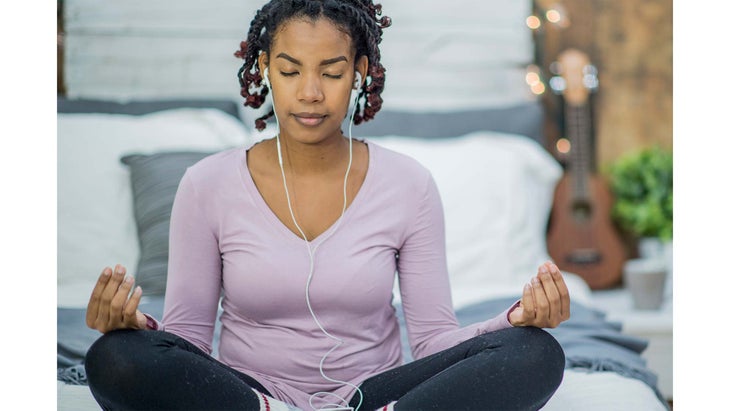
Meditation helps us create space between a stimulus (external or internal) and our response to it. It brings presence and mindfulness into the way we live our lives and gives us the ability to see things for what they are. Creating that space in the mind really helps us see the anxiety for what it is and buffers the intensity of the emotional charge to it. Most of the time, if fully immersed in meditation, the anxiety completely disappears.
How-to: Find a comfortable place in your home that you will return to daily. Begin by turning your phone on airplane mode and setting a timer for yourself. I suggest starting with 5 minutes a day, then gradually move to 10, and eventually longer. Find a comfortable seat and start by simply taking a few deep breaths. Allow your eyes to close and begin to notice the weight of your body, and the points of contact with the ground. Notice the sounds around you, then come back to your body and do a quick scan of it, noticing how your physical body is currently feeling and noticing your overall mood as well. Then, bring your attention to your breath: Where is your breath moving as you inhale and exhale? How quickly (or slowly) are you breathing? Take the next few moments in stillness to just observe and listen to your breathing. When you are done, slowly open your eyes and take a moment to thank yourself for taking the time for yourself.
See also A Yoga Sequence to Train Your Brain to Relax
2. Belly Breathing

Anxiety tends to manifest itself as tension in the shoulders and abdomen, from continuous breathing mainly in the upper chest and collarbone region. Constant clavicular breathing like this can signal to our sympathetic system that we are in stress. To counter that, try breathing into your belly, which allows the diaphragm to properly descend and expand, stimulating the parasympathetic system (our rest and digest mode!) and helps shift us into a calmer state.
How-to: Either sitting or lying down, place your hands on your belly and begin to slowly breathe into your hands. As you inhale, feel your belly expand; as you exhale, feel your belly fall. Breathe slowly and do your best to fully expand your belly and then fully let it relax as you breathe. If you have trouble expanding your abdomen, use your hands to create light pressure on your belly.
See also How Yoga Calms Anxiety Holistically
3. Sama Vritti (Equal Breathing)
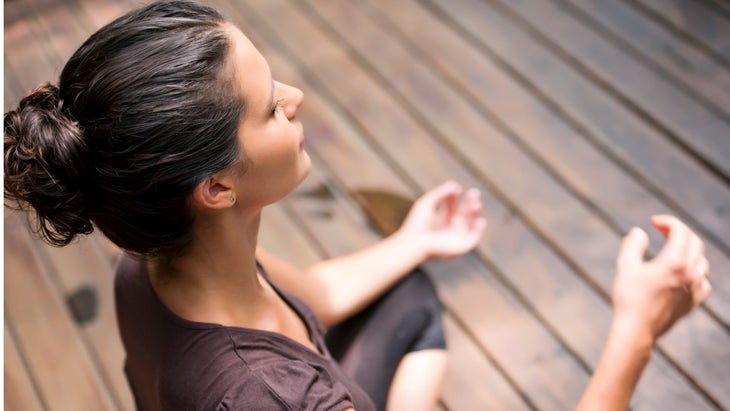
As anyone who’s ever been stressed or calm knows well, your mood can directly impact your breathing. The flip side is true, too: Start breathing quickly and there’s a good chance you’ll feel stressed; slow your breathing and you’ll likely experience a state of calm. Because of this breath-mood connection, it can be particularly helpful to start fresh every day—and equal breathing is an amazing place from which to do that.
How-to: Find a comfortable seat where your spine is in neutral, either on a chair or on a yoga block or bolster, and bring your attention to your breathing. Take a moment to observe what the natural cadence of your breath is like in this present moment. Then, take a slow breath in through your nose, followed by a slow breath out. Then, inhale for a count of four, and exhale for a count of four, keeping the breath smooth and steady. At first it may feel too slow or mechanical if the breath or heart rate is elevated. However, try to repeat this breathing technique for 2-3 minutes or longer. Feel free to close your eyes once you begin counting. When you’re done, your breathing will return to a naturally slower pace, along with your heart rate and sense of ease.
See also Ask the Expert: How Do I Start Practicing Pranayama + Meditation?
4. Body Scan

Anxiety often comes from worry about the future, and the best thing to do when your thoughts begin to go to that scary, unknown place is to get grounded into the present moment through full awareness of your physical body. This body scan can help you do just that. And it can be done either seated or lying down, at any time.
How-to: Begin by thinking consciously about each part of your body, starting from the top of your head and working your way down to your toes. Think of scanning your body evenly and slowly, as if you were slowly moving down the body with a three-dimensional holograph. Bring your full awareness into each part of your body, taking as much time as you need. If you get distracted, simply pick back up where you left off. (Remember, it’s not a science!) Once you are done, take a moment to relax and enjoy the feeling of being fully embodied.
See also Yoga Practices for Veterans: Body Scan
5. Savasana (Corpse Pose)
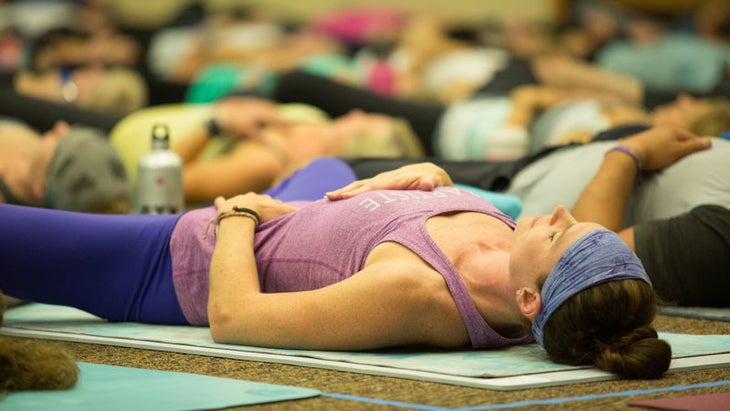
A lot of times, anxiety comes from continuously pushing forward without giving ourselves time to actively relax. Even just a few minutes of deep relaxation—the kind you’ll find practicing Savasana—can completely shift your mental state.
How-to: Lie down on your back on either your yoga mat or bed and take a moment to completely relax. It’s that simple! If it’s difficult to slow down, try putting on some soft music in the background, diffusing lavender essential oil, or place an eye pillow over your eyes. Feel free to include a scan of the body, sama vritti, or belly breathing to help you slow down at first, but then give yourself the time to truly relax for a few minutes in stillness and do nothing.
See also Slow It Down: A Relaxing Savasana Playlist
6. Balasana (Child’s Pose)
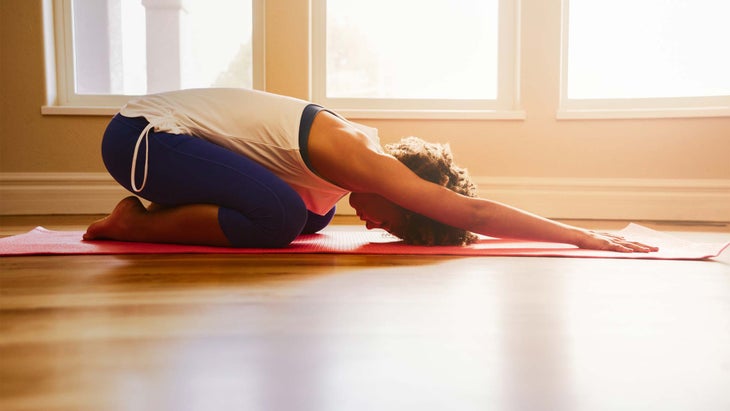
Sometimes anxiety can stem from an overall feeling of not feeling safe in your surroundings—or even in your own body. Practicing this seed-like posture can feel very protective and comforting, as well as help to ground your energy through light pressure of the forehead.
How-to: Begin with your knees wider than your ribcage and your seat resting toward your heels, with your big toes touching. Allow your arms to lengthen in front of you but let your elbows rest so the pose feels truly relaxed. Most importantly, allow your forehead to relax down on your mat. (If it doesn’t reach the mat, place a blanket or two under your forehead until it does, to allow your neck to relax.) Then, begin to take even, slow breaths into the back of your rib cage, staying here for 1-3 minutes.
7. Matsyasana, variation (Restorative Fish Pose)
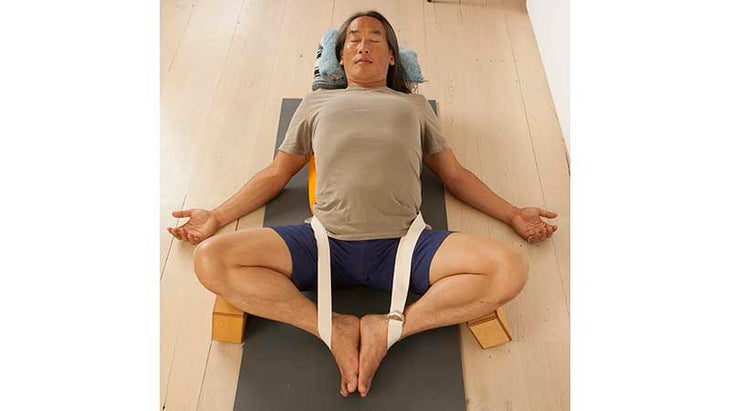
Anxiety can stem from unexpressed feelings of sadness or grief, which can make us want to curl up and hide. Relaxing into a gentle heart opener allows those deep-seated emotions to slowly rise to the surface, helping you gently (but powerfully) release them.
How-to: Start by sitting with your hips in front of a bolster, then slowly recline back onto the bolster and let your arms relax down next to you, with your palms facing up. Feel free to add a blanket under your head for added support. You can either extend your legs or let them rest in butterfly. Once you relax back, allow your eyes to close and try to fully relax into the bolster for 5-10 minutes. Allow any emotions to rise up to the surface and greet them with gratitude. After all, they are no longer hidden! Tears are always a sign positive healing is occurring.
See also Master Fish Pose in 5 Steps